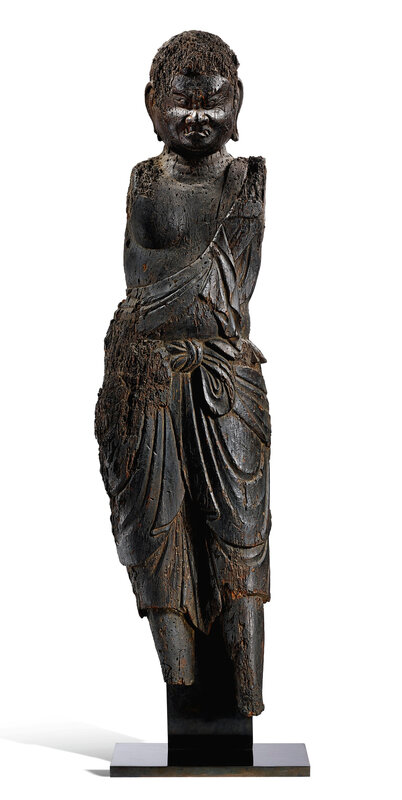A carved wood figure of Fudo Myo-O, Japan, Heian period, 12th century
Lot 3089. A carved wood figure of Fudo Myo-O, Japan, Heian period, 12th century; 92.2 cm, 36 1/4 in. Estimate 600,000 — 800,000 HKD (63,069 - 84,091 EUR). Lot Sold 1,000,000 HKD. © Sotheby's 2018.
the Immovable Wisdom King worked from a single block of cypress wood in the ichiboku zukuri technique, powerfully carved standing with his body leaning to one side, simply dressed with a loincloth knotted at the waist and cascading in waves (hompa) over his hips, his face portrayed with a fierce stare detailed with rolling eyes and exposed fangs, the wood patinated to a dark brown colour, stand.
The outcome of Carbon-14 testing is consistent with the dating of this lot.
Provenance: An American private collection, Rhodes Island.
Shirley Day, London.
Note: Wood sculpture of the Heian period in Japan count among the most powerful Buddhist images, and this particularly moving sculpture of Fudo Myo-o can be compared to other masterpieces of wood carving of the period such as the Guardian King of the Four Directions preserved in the Metropolitan Museum of Art, accession number 1975.268.165, illustrated on https://www.metmuseum.org/art/collection/search/44840.
Its specific iconography is related to the very famous early Heian painting of the red Fudo preserved in the Myoo-in of the mount Koya temple in Wakayama, the main centre of Esoteric (Shingon) Buddhism in Japan, published in Sherman E. Lee, A History of Far Eastern Art, New York, 1964, p. 289, fig. 1.
Fudo, one of the Five Wisdom Kings (Myo-o) and protector of the faithful, is here similarly depicted with furrowed brows, rolling glaring eyes and typically with one protruding fang up and the other down. He would have been holding a vajra sword in his right hand, with a thunderbolt and dragon coiled along the blade, and a coiled rope (kensaku) in his left hand. He wears a simple loincloth knotted around his waist and cascading in waves (hompa) down his thigh. This sculptural style of draperies originally derived from the colossal Buddha that was formerly in Bamyan, Afghanistan, and was an important focus for the Buddhist pilgrims travelling along the central Asia route to India (ibid., p. 286).
A dating to the mid Heian period, corroborated by a carbon test placing this figure within the eleventh to twelfth century, well illustrated the prevalence during the earlier Heian or Jogan period of the precepts of Esoteric Buddhism, while the worship of the Buddha of the West Amida would become more preeminent during the latter part of the Heian or Fujiwara period.
The conception of the sculpture, carved in one block in the ichiboku-zukuri technique is also consistent with an earlier Heian period dating, wood sculptures of the latter Heian and succeeding Kamakura period being usually conceived from hollowed out segments, carved separately and subsequently re-assembled together (yosegi and warihagi zukuri). This would also explain the loss of the arms which had probably been carved separately from different blocks and affixed to the torso.
Sotheby's. Curiosity IV, Hong Kong, 02 Apr 2018, 10:30 AM

/https%3A%2F%2Fprofilepics.canalblog.com%2Fprofilepics%2F1%2F0%2F100183.jpg)
/https%3A%2F%2Fstorage.canalblog.com%2F03%2F02%2F119589%2F96711876_o.jpg)
/https%3A%2F%2Fstorage.canalblog.com%2F11%2F31%2F119589%2F94773502_o.jpg)
/https%3A%2F%2Fstorage.canalblog.com%2F20%2F83%2F119589%2F94772815_o.jpg)
/https%3A%2F%2Fstorage.canalblog.com%2F26%2F72%2F119589%2F75604929_o.jpg)
/https%3A%2F%2Fstorage.canalblog.com%2F59%2F60%2F119589%2F26458628_o.jpg)





/http%3A%2F%2Fstorage.canalblog.com%2F94%2F98%2F119589%2F128936844_o.jpg)
/http%3A%2F%2Fstorage.canalblog.com%2F10%2F21%2F119589%2F128720387_o.jpg)
/http%3A%2F%2Fstorage.canalblog.com%2F66%2F59%2F119589%2F128562333_o.jpg)
/http%3A%2F%2Fstorage.canalblog.com%2F10%2F39%2F119589%2F127811495_o.jpg)